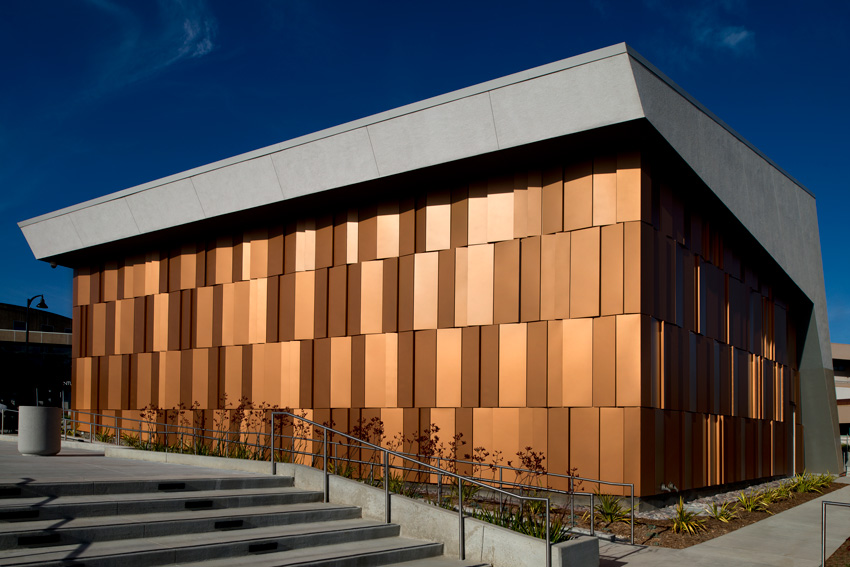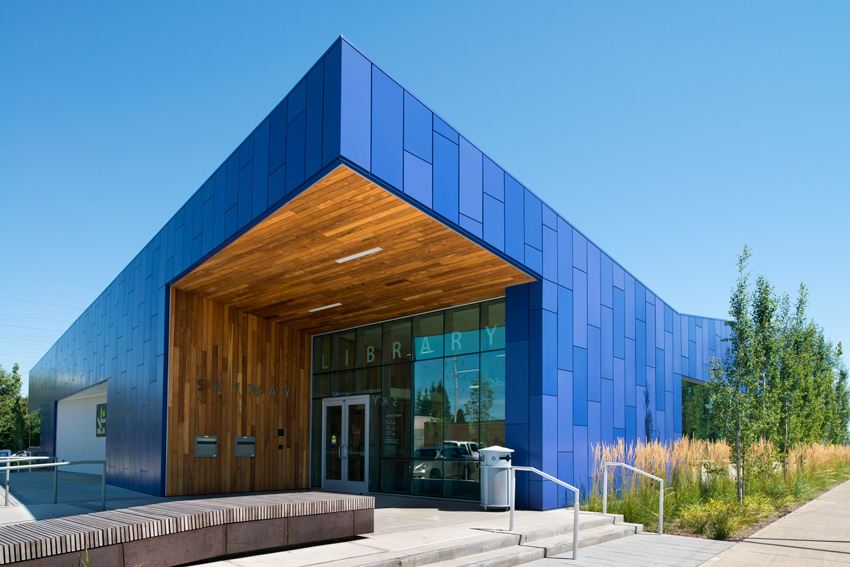Form and Function
Single-Skin Metal Panels
Single-skin metal panels do not have any laminated layers or core material. They are comprised of a single skin, or sheet, of metal. Panels can be created either via rollformed panels produced from metal coil; by using press-broken profile panels made from sheet metal; or through cassette or plate panels formed from sheet metal, which can offer more sophistication within the structure. Systems can employ either a concealed or exposed fastener system.
Single-skin metal panels offer several advantages. Due to their composition, they avoid delamination. Single-skin systems are easier to install and can be more cost-effective than composite systems. Additionally, single-skin panels offer a wider variety of metals and finishes.
The disadvantage of single-skin panels is its size limitation. Without a laminated core material, panel sizes cannot be made as large as composites due to the possibility of face deflection.

Photo courtesy Dri-Design, Inc.
The Applied Science Center at Ventura College in Ventura, California, uses tapered single-skin metal panels in charcoal, classic copper, and silver color finishes to create visual interest and highlight the angles of the exterior installation.
DIGGING DEEPER: SINGLE-SKIN AESTHETICS
Because they are created from metal, single-skin panels are available in variety of architectural metal options, including steel, aluminum, zinc, copper, titanium, stainless steel, and weathering steel. The most commonly specified architectural metals include steel, aluminum, zinc, and copper. Other, less commonly specified metals include titanium, stainless steel, and weathering steel.
Steel is the least expensive of architectural metals. When single-skin metal panels are specified as steel, the steel used is typically either aluminized, like Galvalume, or galvanized. G90 is the most popular galvanized type. It is commonly finished through the process of coating while in coil form, using paints containing Kynar or similar resins. Commonly available gauges for exterior steel metal panels are 18 (1.19 millimeters), 20 (0.91 millimeter), 22 (0.76 millimeter), and 24 (0.60 millimeter). The lower the gauge number, the thicker and stronger the steel material will be.
Aluminum, the first metal widely used on exteriors, remains a popular choice today. Aluminum offers added corrosive protection over steel. Aluminum is typically coated (painted) or anodized. Mill-finished aluminum in architectural applications is rare because of natural oxidation. For projects concerned with environmental status and certification, design professionals need to check aluminum sourcing.
Zinc is a natural metal alloy that develops a protective patina. Typically available in mill finish (shiny) as well as pre-weathered gray or black, technological advances mean today’s zinc offers some color options by using pigment infused in a clear coat. The zinc surface is self-healing and offers excellent maintenance characteristics. Zinc has definite environmental benefits: a low amount of energy is needed to produce the raw material, and it has high amounts of recycled content. There also is limited runoff from zinc panels. Any runoff that does occur is nonstaining and becomes immediately non-bioavailable (unable to be absorbed and used by the body) upon contact with soil.
Copper, the last of the most popular metal choices for single-skin metal panels, is a natural metal that develops a patina. It is available in both mill finish (shiny) as well as pre-patinated. The thickness is measured by ounce; 24, 32, and 48 ounces are common gauges for architectural panels. Copper has similar long life expectancies to zinc. However, water runoff from copper panels can stain adjacent materials. This material is also expensive, costing approximately twice the amount of zinc.
Besides the array of natural metal choices, single-skin metal panels are available in a variety of finishes: PVDF coatings, FEVE coatings, and anodizing aluminum. Steel and aluminum typically require finishing for longevity of the material in exterior applications as well as to achieve the desired appearance.
PVDF, short for polyvinylidene fluoride, is a resin used in architectural paints. The paints come in both liquid and powder form. This finish offers a wide variety of color options. PVDF finishes are widely used and offer excellent ultraviolet (UV) resistance.
FEVE stands for fluoroethylene and vinyl ether and is a style of paint. Fluorinated segments protect the vinyl ether segments from degradation by UV light and chemicals, while the vinyl ether segments impart solubility, gloss, pigment compatibility, adhesion, and reactivity. FEVE can also be used in unique printing techniques to create realistic faux finishes and intricate designs on metals.
Anodizing is the process of electrochemically controlling, accelerating, and enhancing oxidation of an aluminum substrate. The process produces a uniform oxide that becomes an integral part of the metal and protects the rest of the aluminum substrate from deterioration. Anodizing creates a durable, abrasion-resistant finish and resists effects of temperature, corrosion, humidity, and warping. It has a long life cycle, is 100 percent recyclable, and poses no health risks.
The electrolytic two-step anodizing process takes place in a tank that contains a solution of sulfuric acid and water. The tank is charged with electrical current, and aluminum oxide is formed on the surface of the aluminum. This produces a clear or silver finish. The material can then be immersed in a coloring tank. In the coloring tank, the anodized aluminum is immersed in a bath containing an inorganic metal.
The Aluminum Association has created specific designations dividing anodizing finishes into Architectural Class I and Class II Anodic Coatings. A Class I coating has a mil thickness of 0.7 (18 microns) or greater and is most suitable for exterior applications. A Class II coating, with a minimum mil thickness of 0.4 (10 microns), is best for interior applications and light exterior exposures.
Copper anodizing offers the opportunity to simulate the look of true copper, providing the look of copper penny tones while avoiding the disadvantages of natural copper. The process uses real copper to achieve the color, but the finish will not patina over time. It does not require a clear coat or ongoing treatment to maintain color. The material can be designed for use adjacent to other aluminum materials without galvanic corrosion risk. It also will not leave copper runoff stains on the building’s exterior. Since it is applied to aluminum, it is less than half the weight of real copper.
The single-skin metal panel system provides nearly endless design possibilities, with an unlimited palette of colors, finishes, materials, textures, and custom perforations, including imaging. Nevertheless, a material must do more than meet aesthetic challenges. It must combine beautiful design with new objectives about the way a system can perform, both at the time of installation and for decades later.

Photo courtesy Dri-Design, Inc.
The Shops at Clearfork in Fort Worth, Texas, demonstrate perforated single-skin metal panels with an anodized finish.










